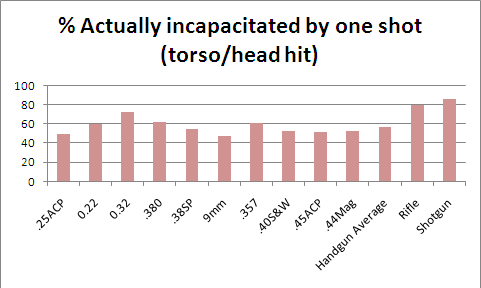You are right in that the ability to incapacitate is about equal. In this study, incapacite is not dead, it simply means the attacker stopped the attack.
From the article:
What is telling in the smaller calibers is the percentage of people who were NOT incapacitated. The .32 caliber and smaller rounds have double the amount of attackers who failed to stop after the first hit.
https://www.buckeyefirearms.org/alternate-look-handgun-stopping-power
Accuracy is a base fundamental with every lethality study I have seen concluding the same thing. At close ranges, shot placement is much more important than caliber.
The failure to stop percentages I believe accurately show the trend. Even in Afghanistan, we experienced multiple instances of .22 caliber bullets (5.56mm) with good shot placement failing to stop an opponent.
Statistically, the sample size is very small in this study and your speculation is reasonable. One would be dismissing the data though based upon an assumption.
I think the author adequately address the issue:
From the article:
On average, how many rounds did it take for the person to stop his violent action or be incapacitated?
What is telling in the smaller calibers is the percentage of people who were NOT incapacitated. The .32 caliber and smaller rounds have double the amount of attackers who failed to stop after the first hit.
.22 (short, long and long rifle)
# of people shot - 154
# of hits - 213
% of hits that were fatal - 34%
Average number of rounds until incapacitation - 1.38
% of people who were not incapacitated - 31%
One-shot-stop % - 31%
Accuracy (head and torso hits) - 76%
% actually incapacitated by one shot (torso or head hit) - 60%
.380 ACP
# of people shot - 85
# of hits - 150
% of hits that were fatal - 29%
Average number of rounds until incapacitation - 1.76
% of people who were not incapacitated - 16%
One-shot-stop % - 44%
Accuracy (head and torso hits) - 76%
% actually incapacitated by one shot (torso or head hit) - 62%
Some people will look at this data and say "He's telling us all to carry .22s". That's not true. Although this study showed that the percentages of people stopped with one shot are similar between almost all handgun cartridges, there's more to the story. Take a look at two numbers: the percentage of people who did not stop (no matter how many rounds were fired into them) and the one-shot-stop percentage. The lower caliber rounds (.22, .25, .32) had a failure rate that was roughly double that of the higher caliber rounds. The one-shot-stop percentage (where I considered all hits, anywhere on the body) trended generally higher as the round gets more powerful.
https://www.buckeyefirearms.org/alternate-look-handgun-stopping-power
Accuracy doesn't explain it
Accuracy is a base fundamental with every lethality study I have seen concluding the same thing. At close ranges, shot placement is much more important than caliber.
The failure to stop percentages I believe accurately show the trend. Even in Afghanistan, we experienced multiple instances of .22 caliber bullets (5.56mm) with good shot placement failing to stop an opponent.
Statistically, the sample size is very small in this study and your speculation is reasonable. One would be dismissing the data though based upon an assumption.
I think the author adequately address the issue:
In a certain (fairly high) percentage of shootings, people stop their aggressive actions after being hit with one round regardless of caliber or shot placement. These people are likely NOT physically incapacitated by the bullet. They just don't want to be shot anymore and give up! Call it a psychological stop if you will. Any bullet or caliber combination will likely yield similar results in those cases. And fortunately for us, there are a lot of these "psychological stops" occurring. The problem we have is when we don't get a psychological stop. If our attacker fights through the pain and continues to victimize us, we might want a round that causes the most damage possible.

